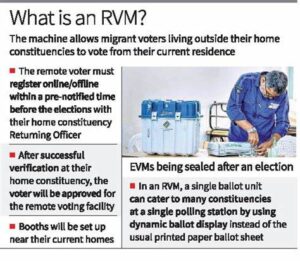Published on: December 30, 2022
Remote EVM
Remote EVM
Why in news? The Election Commission announced the development of a prototype of a multi-constituency remote electronic voting machine (RVM) to enable remote voting by migrant voters.
Highlights
- This machines can handle multiple constituencies from a single remote polling booth
- The EC invited all recognised political parties eight national and 57 State parties to a demonstration of the prototype
- The idea was to implement voter portability as a pilot project in the Assembly elections in nine States in 2023 and if successful, will fully implemented in the 2024 Lok Sabha election.
What was the need for the RVM?
- Voter not opting to register in a new place of residence, thus missing out on exercising the right to vote will be taken care .
- The inability to vote due to internal migration is one of the prominent reasons to be addressed to improve voter turnout and ensure participative elections
- Out-migration due to the need to work, marriage, and education is predominant among the rural population in overall domestic migration will be addressed
Migrant workers
- Definition of migrant voter to be reworked with respect to retaining registration at the original place in the context of the legal construct of “ordinary residence” and “temporary absence”.
- The territorial constituency concept of remote voting and defining remoteness, that is an outside constituency, outside district or outside State will need to be dealt with.
What are the challenges ?
Administrative challenges
- Enumerating remote voters’ self-declaration
- Ensuring secrecy of voting at remote locations
- Provision of polling agents at remote voting booths, and ensuring identification of voters to avoid impersonation.
Technological challenges
- The method of remote voting, the familiarity of the voters with the multi-constituency RVM and counting of votes.
Other areas
- The work include the appointment of polling personnel for remote polling stations and supervision
- The number of polling booths to be set up and their locations
- Implementation of the Model Code of Conduct in remote locations.

